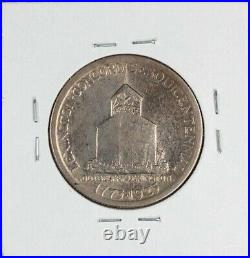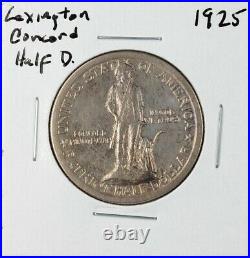


United States of America. Lexington-Concord Sesquicentennial 1925 Silver 50 Cents (Half Dollar) 30.6mm (12.50 grams) 0.900 Silver 0.3617 oz. UNITED STATES OF AMERICA PATRIOT HALF DOLLAR CONCORD MINUTE-MAN IN GOD WE TRUST, Minute man standing facing with a musket. This coin was designed by Chester Beach. The famous statue of the Minute Man by Daniel Chester French which is located in Concord was used for the obverse design. The reverse depicts the old Belfry at Lexignton. The Minute Man statue adjacent to the North Bridge in the Minute Man National Historical Park. Old Belfry in Belfry Hill Park, Clarke Street. Plaque reads: This belfry was erected on this hill in 1761 and removed to the Common in 1768. In it was hung the bell which rung out the alarm on the 19th of April 1775. In 1797 it was removed to the Parker Homestead in the south part of the town. In 1891 it was brought back to this hill by the Lexington Historical Society. Destroyed by a gale in 1909. Minute Man National Historical Park. Commemorates the opening battle in the American Revolutionary War. It also includes The Wayside, home in turn to three noted American authors. The National Historical Park is under the jurisdiction of the National Park Service and protects 970 acres 3.9 km. In and around the towns of Lexington, Massachusetts, Lincoln, Massachusetts, and Concord, Massachusetts. Battles of Lexington and Concord. Were the first military engagements of the American Revolutionary War. The battles were fought on April 19, 1775 in Middlesex County, Province of Massachusetts Bay, within the towns of Lexington, Concord, Lincoln, Menotomy (present-day Arlington), and Cambridge. They marked the outbreak of armed conflict between the Kingdom of Great Britain and its thirteen colonies in America. In late 1774, Colonial leaders adopted the Suffolk Resolves in resistance to the alterations made to the Massachusetts colonial government by the British parliament following the Boston Tea Party. The colonial assembly responded by forming a Patriot provisional government known as the Massachusetts Provincial Congress and calling for local militias to train for possible hostilities. The Colonial government exercised effective control of the colony outside of British-controlled Boston. In response, the British government in February 1775 declared Massachusetts to be in a state of rebellion. About 700 British Army regulars in Boston, under Lieutenant Colonel Francis Smith, were given secret orders to capture and destroy Colonial military supplies reportedly stored by the Massachusetts militia at Concord. Through effective intelligence gathering, Patriot leaders had received word weeks before the expedition that their supplies might be at risk and had moved most of them to other locations. On the night before the battle, warning of the British expedition had been rapidly sent from Boston to militias in the area by several riders, including Paul Revere and Samuel Prescott, with information about British plans. The initial mode of the Army’s arrival by water was signaled from the Old North Church in Boston to Charlestown using lanterns to communicate “one if by land, two if by sea”. The first shots were fired just as the sun was rising at Lexington. Eight militiamen were killed, including Ensign Robert Munroe, their third in command. The British suffered only one casualty. The militia were outnumbered and fell back, and the regulars proceeded on to Concord, where they broke apart into companies to search for the supplies. The outnumbered regulars fell back from the bridge and rejoined the main body of British forces in Concord. The British forces began their return march to Boston after completing their search for military supplies, and more militiamen continued to arrive from neighboring towns. Gunfire erupted again between the two sides and continued throughout the day as the regulars marched back towards Boston. Upon returning to Lexington, Lt. Smith’s expedition was rescued by reinforcements under Brigadier General Hugh Percy, a future duke of Northumberland styled at this time by the courtesy title Earl Percy. The combined force of about 1,700 men marched back to Boston under heavy fire in a tactical withdrawal and eventually reached the safety of Charlestown. The accumulated militias then blockaded the narrow land accesses to Charlestown and Boston, starting the Siege of Boston. Ralph Waldo Emerson describes the first shot fired by the Patriots at the North Bridge in his “Concord Hymn” as the “shot heard round the world”. This item is in the category “Coins & Paper Money\Coins: US\Commemorative\Silver (1892-1954)”. The seller is “chiosa_llc” and is located in this country: US. This item can be shipped worldwide.
- Country/Region of Manufacture: United States
- Certification: Uncertified
- Mint Location: Philadelphia
- Grade: Ungraded
- Year: 1925
- Circulated/Uncirculated: Unknown
- Composition: Silver
- Denomination: 50C

